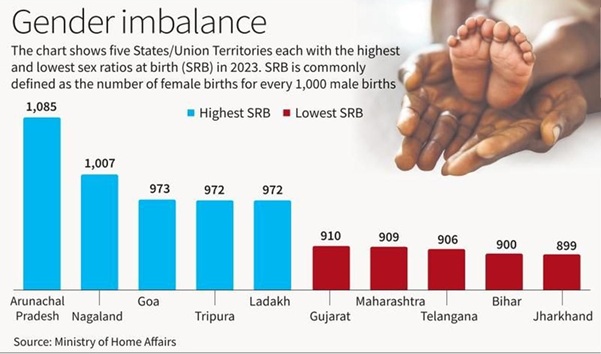| (Prelims: Important Reports and Index) |
Why in News
On October 13, 2025, the India Births and Deaths Report, 2023 was released by the Registrar General of India, under the Ministry of Home Affairs.

About the Report
- Title: 'Vital Statistics of India Based on Civil Registration System'
- What it is: It is an official record of births and deaths in India. This data helps in population, health, and development planning.
- Method: Registration of births and deaths is mandatory under the Registration of Births and Deaths Act, 1969.
- Information is given to the local registrar within 21 days of the event (birth/death).
- States and Union Territories collect data through their Chief Registrars, which is uploaded to a central portal.
- Real-time registration is achieved through a digital system (after the 2023 revision).
Key Points of the Report
- Decline in birth rate: A total of 25.2 million births occurred in 2023, a decrease of 23.2 million from the previous year (2022).
- Slight increase in mortality rate: 8.66 million deaths were recorded in 2023, a slight increase from 2022.
- COVID-19 and mortality: A large number of deaths occurred in 2021 due to the COVID-19 pandemic.
- 8.12 million deaths were recorded in 2020 and 10.22 million deaths in 2021.
- The number of deaths due to COVID-19 was 533,665 till May 2025.
- A good sex ratio ensures gender equality, strong families, and sustainable development.
- Sex Ratio: Jharkhand had the lowest sex ratio (child sex ratio) at 899, followed by Bihar at 900.
- The best sex ratio was in Arunachal Pradesh, where it was 1085.
- Institutional Births: The share of institutional births in 2023 was 74.7%, although data for Sikkim was not included in the report.
- Birth Registration Rate: The overall birth registration rate in India was 98.4% in 2023.
- 11 states/union territories achieved registration rates above 90%.
Key Concerns
- This gender imbalance is socially and economically harmful.
- A shortage of girls leads to problems such as men not finding marriage partners, increased violence against women, human trafficking, and child marriage.
- A good sex ratio ensures gender equality, strong families, and sustainable development.
Challenges
- Lack of registration: Many births and deaths go unrecorded due to lack of awareness in rural and remote areas.
- Gender discrimination: Son preference, illegal sex determination tests, and female foeticide.
- Data quality: Such as increasing deaths without medical assistance (53.4%).
- Regional disparities: More problematic in northern states (Bihar, Uttar Pradesh), while the situation is better in southern states.
- Pandemic impact: COVID-19 has disrupted registration, though improvement is expected in 2023.
Way forward
- Awareness campaigns: Strengthen programs like "Beti Bachao Beti Padhao" and provide education in schools and villages.
- Legal enforcement: Strict enforcement of the PCPNDT Act, crackdown on illegal clinics.
- Digital reforms: Strengthen the CRS portal, facilitate easy registration through a mobile app.
- Health access: Increase hospitalization in rural areas to increase institutional births to 90%.
- Monitoring: Set state-wise targets and regularly review by linking the National Family Health Survey (NFHS) and the Civil Registration System (CRS).



